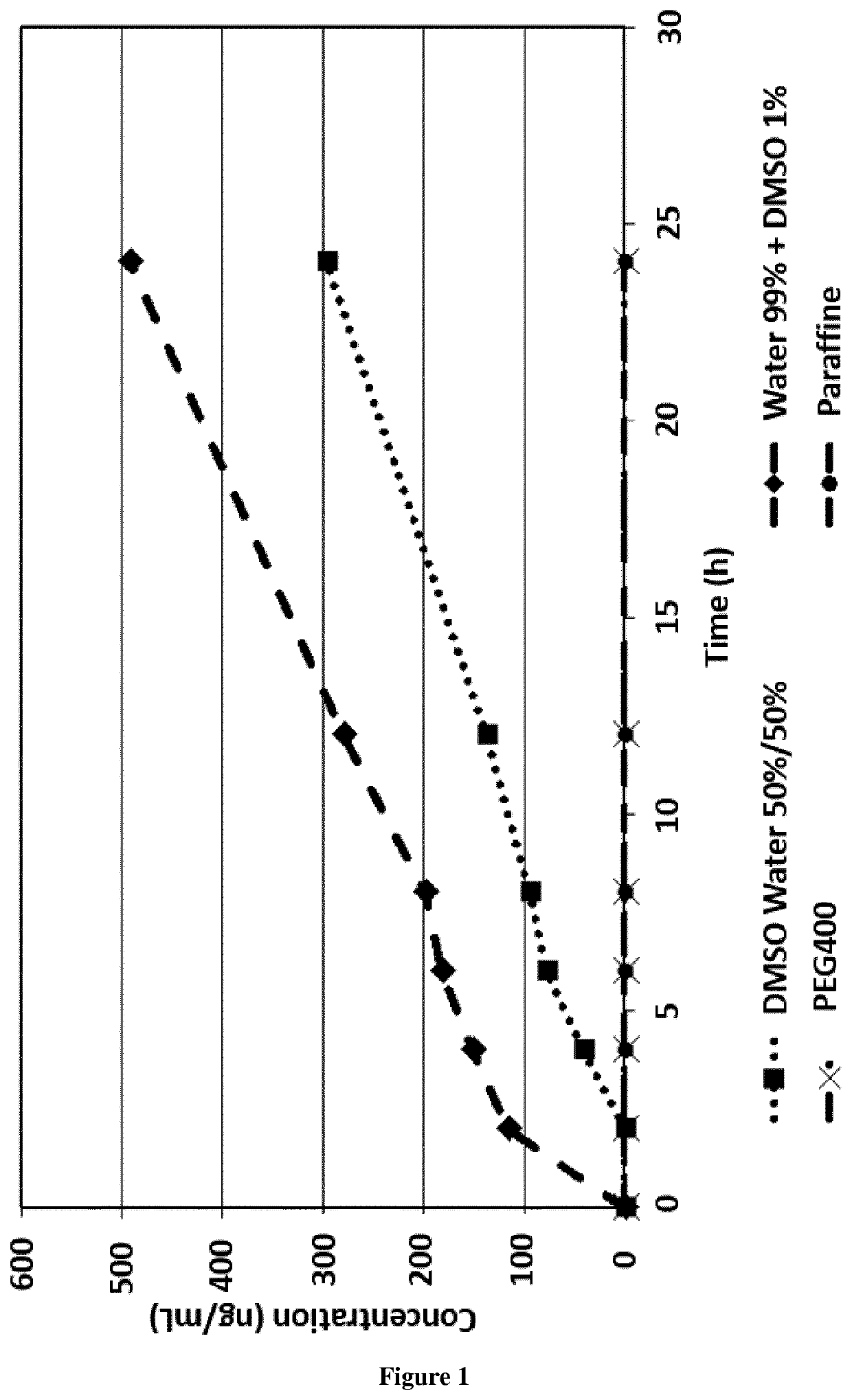Methods and topical pharmaceutical compositions for the treatment of skin microvascular dysfunction
a technology of microvascular dysfunction and composition, applied in the direction of drug composition, metabolic disorder, cardiovascular disorder, etc., can solve the problems of ulceration and subsequent infection, ulceration, infection,
- Summary
- Abstract
- Description
- Claims
- Application Information
AI Technical Summary
Benefits of technology
Problems solved by technology
Method used
Image
Examples
example 1
ation
[0037]Method:
[0038]The t-AUCB and GSK2256294 percutaneous absorptions were determined using Franz's cell. The skin of a pig's ears was chosen for the experiments as it is very similar to that of a human skin. Franz's cells had a contact area of 2 cm2 and the experiments were conducted at 32° C. The donor compartment was filled by a solution of 2 mL at 4 μg / g of t-AUCB and 2 mL at 40 μg / mL, 20 μg / mL or 4 μg / mL of GSK2256294. Various vehicles were tested to determine the most favourable one to the cutaneous absorption. The receptor compartment contained 4.5 mL of PBS and was under magnetic stirring. Samples from the receptor compartment were collected for 24 hours at different times to determine the flow of t-AUCB or GSK2256294 percutaneous absorption. Samples were frozen at −20° C. The t-AUCB or GSK2256294 quantification was realized by HPLC / MS / MSS.
[0039]Results:
[0040]The percutaneous absorption study was conducted with a solution of t-AUCB at 4 μg / g in 4 different vehicles: PEG...
example 2
ons Using DMSO
[0043]Method:
[0044]The t-AUCB topical formulation used DMSO and water as vehicle. The experiments were conducted with Franz's cell using the skin of a pig's ear. The donor compartment was filled by 13 μL of DMSO solution with a concentration between 100 to 400 μg / g of t-AUCB. The receptor medium was constituted by 4.5 mL of PBS and was at 32° C. and under magnetic stirring. Samples from the receptor compartment were collected at different times over 24 hours to determine the passage flow of t-AUCB. Samples were then frozen at −20° C. The t-AUCB quantification was realized by HPLC / MS / MSS.
[0045]Results:
[0046]The t-AUCB flows with a concentration between 100 to 400 μg / g in DMSO solution between 25% and 100% are represented in FIG. 3. The most important flow is obtained with the solution of t-AUCB with a concentration of 400 μg / g and in the 100% DMSO with 131.26 ng / cm2 / h. The solution containing 25% of DMSO and 100 μg / g of t-AUCB presented a flow of 19.59 ng / cm2 / h. The pas...
example 3
ons Using Alcohol
[0047]Method:
[0048]Alcohol and water were used as a vehicle for t-AUCB's topical formulation. The experiments were conducted with Franz's cell using the skin of a pig's ear. The donor compartment was filled by an 13 μL of alcoholic solution with a concentration between 100 to 200 μg / g of t-AUCB The receptor medium was constituted by 4.5 mL of PBS, was at 32° C. and under magnetic stirring. Samples from the receptor compartment were collected at different times over 24 hours to determine the passage flow of t-AUCB. Samples were then frozen at −20° C. The t-AUCB quantification was realized by HPLC / MS / MSS.
[0049]Results:
[0050]FIG. 4 represents the passage of hydroalcoholic solutions of t-AUCB with an alcohol content between 50 and 75% and with a t-AUCB concentration between 100 and 200 μg / g. The percutaneous flow is higher with either a larger alcohol content or a larger concentration of t-AUCB. The most important flow was obtained by a t-AUCB solution 200 μg / g in alcoh...
PUM
| Property | Measurement | Unit |
|---|---|---|
| area | aaaaa | aaaaa |
| pH | aaaaa | aaaaa |
| lag time | aaaaa | aaaaa |
Abstract
Description
Claims
Application Information
 Login to View More
Login to View More - R&D
- Intellectual Property
- Life Sciences
- Materials
- Tech Scout
- Unparalleled Data Quality
- Higher Quality Content
- 60% Fewer Hallucinations
Browse by: Latest US Patents, China's latest patents, Technical Efficacy Thesaurus, Application Domain, Technology Topic, Popular Technical Reports.
© 2025 PatSnap. All rights reserved.Legal|Privacy policy|Modern Slavery Act Transparency Statement|Sitemap|About US| Contact US: help@patsnap.com



